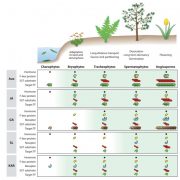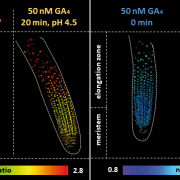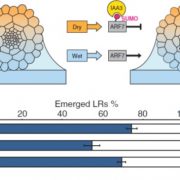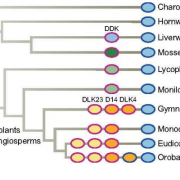Fresh as an Exitron: A Flower-specific Splice Variant of AUXIN RESPONSE FACTOR8 Helps Shape the Stamen
Eukaryotic genes contain protein-coding exons interspersed with non-coding introns. While introns are usually spliced out of mRNA (often in conjunction with various exons), intron retention usually causes mRNA to remain in the nucleus instead of being exported to the cytoplasm for translation. This process stalls gene expression at a particular stage, tissue, or condition, thereby regulating development or stress responses. To complicate matters, some exons contain exitrons (Marquez et al., 2015). These intron-like regions allow intraexonic protein-coding sequences to be differentially spliced, yielding different mRNAs. However, in contrast to canonical intron retention, transcripts with retained exitrons exit the nucleus for translation into different proteins in a tissue-specific manner.
Such plasticity no doubt comes in handy during flower development, when relatively few transcription factors orchestrate the expression of scores of genes. Thousands of transcripts generated by alternative splicing, including intron retention, are differentially expressed during Arabidopsis thaliana flower development (Wang et al., 2014).
For example, the splice variant ARF8.2 has been found for AUXIN RESPONSE FACTOR8, encoding a transcription factor that binds to auxin response elements in the promoters of target genes to control their expression. Auxin in developing stamens upregulates AUX/IAA19 levels and controls the degradation of this transcriptional repressor, thus preventing ARF8 from binding to its targets. This repression results in filament elongation, explaining the short stamens of the arf8 mutant.
While exploring possible roles for ARF8.2 in stamen development, Ghelli et al. (2018) came across an intriguing new splice variant, ARF8.4. ARF8.4 is exclusively expressed in stamens during late development and is translated and efficiently transported to the nucleus, as revealed by transient expression analysis, indicating that it contains a retained exitron. To investigate its role, the authors produced Arabidopsis arf8 lines harboring the full-length ARF8.1, ARF8.2, and ARF8.4 coding sequences driven by an inducible promoter (ARF8.1ox-arf8, ARF8.2ox-arf8, and ARF8.4ox-arf8, respectively). Only ARF8.4 fully complemented the short-stamen phenotype of arf8, pointing to its role in stamen elongation. AUX/IAA19 was upregulated in ARF8.4ox-arf8 plants, perhaps explaining their increased stamen length, as confirmed by chromatin immunoprecipitation-qPCR.
 Wild-type and arf8 plants coexpressing ARF8.2 and ARF8.4 showed precocious anther dehiscence (see figure), whereas ARF8.2ox and ARF8.4ox plants did not. Anther dehiscence is linked to the indirect activation of the jasmonic acid (JA) biosynthesis gene DEFECTIVE IN ANTHER DEHISCENCE1 (DAD1) by ARF8. ARF8.2ox flowers had increased DAD1 transcript levels, whereas ARF8.4ox flowers did not, suggesting that ARF8.2 regulates anther dehiscence by affecting JA biosynthesis. Histological analysis suggested that ARF8.4 regulates lignin deposition, an early step in anther dehiscence. This process is controlled by the transcription factor MYB26, whose expression is negatively regulated by auxin (Cecchetti et al., 2013). Indeed, ARF8.4 binds strongly to the MYB26 promoter and regulates its expression, whereas ARF8.2 has only minor effects on this gene.
Wild-type and arf8 plants coexpressing ARF8.2 and ARF8.4 showed precocious anther dehiscence (see figure), whereas ARF8.2ox and ARF8.4ox plants did not. Anther dehiscence is linked to the indirect activation of the jasmonic acid (JA) biosynthesis gene DEFECTIVE IN ANTHER DEHISCENCE1 (DAD1) by ARF8. ARF8.2ox flowers had increased DAD1 transcript levels, whereas ARF8.4ox flowers did not, suggesting that ARF8.2 regulates anther dehiscence by affecting JA biosynthesis. Histological analysis suggested that ARF8.4 regulates lignin deposition, an early step in anther dehiscence. This process is controlled by the transcription factor MYB26, whose expression is negatively regulated by auxin (Cecchetti et al., 2013). Indeed, ARF8.4 binds strongly to the MYB26 promoter and regulates its expression, whereas ARF8.2 has only minor effects on this gene.
Therefore, two ARF8 splice variants control different steps in stamen development, with the evolutionarily conserved exitron-retaining splice variant ARF8.4 playing crucial roles in this process. Whether this fresh take on flower development represents a general mechanism in plant organ development remains to be explored.
Cecchetti, V, Altamura, M.M., Brunetti, P., Petrocelli, V., Falasca, G., Ljung, K., Costantino, P., and Cardarelli, M. (2013) Auxin controls Arabidopsis anther dehiscence by regulating endothecium lignification and jasmonic acid biosynthesis. Plant Journal 74: 411-422
Ghelli, R., et al. (2018). A newly identified flower-specific splice variant of Auxin Response Factor8 regulates stamen elongation and endothecium lignification in Arabidopsis. Plant Cell 30: doi:10.1015/tpc17.00840.
Marquez, Y., Höpfler, M., Ayatollahi, Z., Barta, A., and Kalyna, M. (2015). Unmasking alternative splicing inside protein-coding exons defines exitrons and their role in proteome plasticity. Genome Res. 25: 995-1007.
Wang, H., You, C., Chang, F., Wang, Y., Wang, L., Qi, J., and Ma, H. (2014). Alternative splicing during Arabidopsis flower development results in constitutive and stage-regulated isoforms. Front. Genet. 5: 25.









